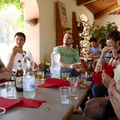Oliviero Toscani
— interview at La Sterpaia with students Andrea, Juri,and Sauro
About
La Sterpaia is a modern workshop of the art of communication. It was founded by Oliviero Toscani in 2005 in collaboration with the Region of Tuscany, and is located in the San Rossore Park near Pisa. This creative lab is focused on finding new languages for different media while responding to a need to wed ideas and markets. It is not a school, nor an agency, but a workshop for young designers to participate in a non-conventional investigation of communication mediums ranging from exhibitions, magazines and films to communication campaigns, websites, fashion shows, journalistic investigations and opinion campaigns.
We arrived at the farm and discovered the small portable building that houses La Sterpaia beyond the barns. The interview was led by 3 of Toscani's students, Juri, Andrea and Sauro. Andrea is a philosophy student, while the two others are studying architecture. The situation seemed unusual, and what we have now come to see as very 'Tuscan'. We felt very welcome and were quickly offered a drink and invited to lunch. The three young designers were generous with their time, hosting us for several hours over lunch, a tour and an interview. Oliviero Toscani, unfortunately, was not present for the interview.
Oliviero Toscani is an artist who lives and works in Tuscany. He is a professional photographer, best known worldwide for designing controversial advertising campaigns for Italian brand Benetton, from 1982 to 2000. In 2005, five years after his resignation from Benetton, he ignited a furious debate over homosexuality with his 'Ra-Re' advert.
— referenced from http://www.lasterpaia.it and http://www.olivierotoscani.comInterview Ideas
- The historical value of great spaces is seen by young Italian designers and architects as oppressive.
- The 'botega' or workshop is a traditional Italian design workshop where new designers work under the guidance of a mentor. The new form of the 'botega' embraces young designers and utilizes an unconventional process of learning by working on real projects with industry professionals.
- Young designers are encouraged to study and practice many different media, as in La Sterpaia where young designers can share ideas in different kinds of arts (i.e. video, graphics and so on).
- Large companies or institutions in Italy embrace and value ideas of young designers to keep Italian design fresh and innovative.
- Location of La Sterpaia is such that it is isolated and ideas are thus more original with less influence from the outside world
Video/Key Quotes
- The Importance of Freedom

- Education and Italian design

- Computer technology and Italian Design

- Philosophy of La Sterpaia

- The Restriction of History on Young Italian designers

- The 'Botega' Being Key in Tuscany

What We Learned
The botega (workshop) is an inspirational model that we can learn from. It could be implemented in Canada; more specifically in Vancouver.
As young Canadian designers often feel limited, so do young Italian designers. This was surprising at first. They feel suppressed by factors contextual to Italy. The first is the historical focus prevalent in Italy - the value placed on 'the old' and the rejection of 'the contemporary.' Many young designers expect to leave Italy to work on exciting projects. The second is the failure of the education system to allow space for freedom, experimentation and development of non-academic ideas. It is felt that this system is not breeding innovation. There are similar sentiments in Canada, and although we face different limitations, a new model may be a step in the right direction to creating more innovative design. Oliviero Toscani is doing just this, investigating new ways to look at design in the form of La Sterpaia. It is a studio that is open-ended, non-conventional and embraces risk-taking.
We've learned that it is common for designers in Italy to overlap fields (i.e. practice architecture, product design, and perhaps be an editor for a magazine at the same time). This cross-over is part of an open process involving risk-taking and seems to lend itself to the success of the designers - they apply a design process to many different creative areas or media. As this is the primary model for working in Italy, it makes sense to create a learning environment for young people that embraces and teaches this model. At La Sterpaia students are encouraged to study and practice many different media, as do professionals in Italy. This trend is not common in Canada and North America, where different fields remain clearly separated. Young Canadian designers could benefit from a similar model, and perhaps we can find a way to introduce it. Perhaps we can take from our experience in Italy the capacity to articulate what breeds innovation and what does not, and start to change the design culture in Vancouver.
